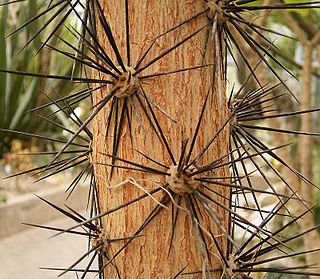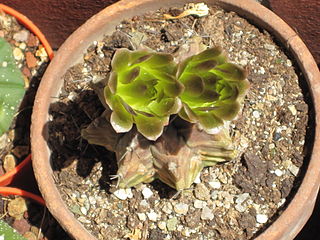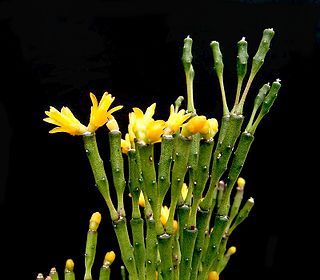
A cactus is a member of the plant family Cactaceae, a family comprising about 127 genera with some 1,750 known species of the order Caryophyllales. The word cactus derives, through Latin, from the Ancient Greek word κάκτος (káktos), a name originally used by Theophrastus for a spiny plant whose identity is now not certain. Cacti occur in a wide range of shapes and sizes. They are native to the Americas, ranging from Patagonia in the south to parts of western Canada in the north, with the exception of Rhipsalis baccifera, which is also found in Africa and Sri Lanka. Cacti are adapted to live in very dry environments, including the Atacama Desert, one of the driest places on Earth. Because of this, cacti show many adaptations to conserve water. For example, almost all cacti are succulents, meaning they have thickened, fleshy parts adapted to store water. Unlike many other succulents, the stem is the only part of most cacti where this vital process takes place. Most species of cacti have lost true leaves, retaining only spines, which are highly modified leaves. As well as defending against herbivores, spines help prevent water loss by reducing air flow close to the cactus and providing some shade. In the absence of true leaves, cacti's enlarged stems carry out photosynthesis.

Euphorbia is a very large and diverse genus of flowering plants, commonly called spurge, in the family Euphorbiaceae. "Euphorbia" is sometimes used in ordinary English to collectively refer to all members of Euphorbiaceae, not just to members of the genus.

In botany, areoles are small light- to dark-colored bumps on cacti out of which grow clusters of spines. Areoles are important diagnostic features of cacti, and identify them as a family distinct from other succulent plants. The spines are not easily detachable, but on certain cacti, members of the subfamily Opuntioideae, smaller, detachable bristles, glochids, also grow out of the areoles and afford additional protection.

Echinopsis is a genus of cacti native to South America, sometimes known as hedgehog cactus, sea-urchin cactus or Easter lily cactus. As of October 2023, there are about 20 accepted species, ranging from large and treelike types to small globose cacti. The name derives from echinos hedgehog or sea urchin, and opsis appearance, a reference to these plants' dense coverings of spines.

Echinocereus is a genus of ribbed, usually small to medium-sized, cylindrical shaped cacti, comprising about 70 species native to the southern United States and Mexico in very sunny, rocky places. Usually the flowers are large and the fruit edible.

Cleistocactus strausii, the silver torch or wooly torch, is a perennial flowering plant in the family Cactaceae. It is native to mountainous regions of Department Tarija, Bolivia, at 1,500–3,000 m (4,921–9,843 ft).

Bergerocactus emoryi is a species of cactus, known commonly as the golden-spined cereus, golden snake cactus, velvet cactus or golden club cactus. It is a relatively small cactus, but it can form dense thickets or colonies, with the dense yellow spines giving off a velvety appearance when backlit by the sun. From April to May, yellow, green-tinged flowers emerge, which transform into reddish, globular fruit. This species is native to the California Floristic Province, and is found in northwestern Baja California and a small part of California, in San Diego County and on the southern Channel Islands. Where the Mediterranean climate of the California Floristic Province collides with the subtropical Sonoran Desert near El Rosario, hybrids with two other species of cacti are found. It is the sole member of the monotypic genus Bergerocactus, named after German botanist Alwin Berger.

Ariocarpus is a small genus of succulent, subtropical plants of the family Cactaceae.

Coryphantha, or beehive cactus, is a genus of small to middle-sized, globose or columnar cacti. The genus is native to arid parts of Central America, Mexico, through Arizona, New Mexico, and western Texas and north into southwestern, central, and southeastern Montana. With its two subgenera, 57 species and 20 subspecies, it is one of the largest genera of cactus.

Obregonia, the artichoke cactus, is a monotypic genus of cacti, containing the species Obregonia denegrii. The species is endemic to the state of Tamaulipas in Mexico.

Rhipsalis is a genus of epiphytic flowering plants in the cactus family, typically known as mistletoe cacti. They are found in parts of Central America, the Caribbean and northern regions of South America. They also inhabit isolated locations in Africa and Asia, and are the only cactus group naturally occurring in the Old World. This is the largest and most widely distributed genus of epiphytic cacti.

Hatiora is a small genus of epiphytic cacti which belongs to the tribe Rhipsalideae within the subfamily Cactoideae of the Cactaceae. Recent taxonomic studies have led to the three species formerly placed in subgenus Rhipsalidopsis being removed from the genus, including the well known and widely cultivated ornamental plants known as Easter cactus or Whitsun cactus.

Myrtillocactus geometrizans is a species of cactus in the genus Myrtillocactus, native to central and northern Mexico.

In botany, succulent plants, also known as succulents, are plants with parts that are thickened, fleshy, and engorged, usually to retain water in arid climates or soil conditions. The word succulent comes from the Latin word sucus, meaning "juice" or "sap".

Gymnocalycium mihanovichii is a species of cactus from South America. The most popular cultivars are varied mutants which completely lack chlorophyll, exposing the red, orange, or yellow pigmentation. These mutant strains are often grafted onto the hylocereus cactus, and the combined plant is called a "Moon Cactus". Moon cacti are commonly grown as houseplants and are also known as Ruby Ball, Red Cap, Red Hibotan, or Hibotan cacti.

Epiphyllum hybrids, epiphyllums, epicacti, or just epis, also known as orchid cacti, which are widely grown for their flowers, are artificial hybrids derived primarily from species of the genus Disocactus. These Disocactus species are not true epiphyllums, but they used to be included in the genus Epiphyllum.

Hatiora salicornioides, the bottle cactus, dancing-bones, drunkard's-dream, or spice cactus, is a species of flowering plant in the cactus family. A member of the tribe Rhipsalideae, it often grows as an epiphyte, natively in eastern Brazil and ornamentally elsewhere.

Oreocereus trollii, commonly known as the Old Man of the Andes cactus, is a species of cacti native to Argentina and Bolivia. Though listed as Least Concern by the IUCN, the plant is collected extensively, and in some areas is threatened.
Michelangelo Console was an Italian botanist primarily known for his work on cacti.

Myrtillocactus cochal, the candelabra cactus, is a species of flowering plant in the family Cactaceae, native to Baja California. Individuals can reach 3 m (10 ft), and are hardy to USDA zone 9b.






















